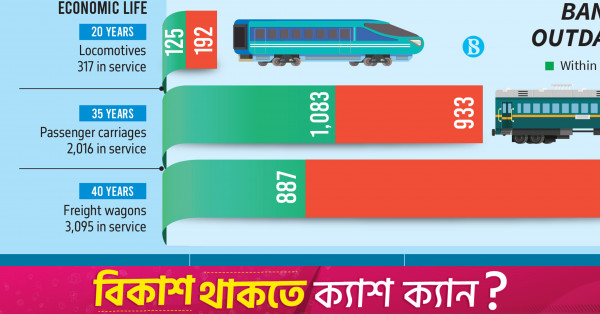As railway lumbers with expired rolling stock, replacements may start next year


In the active fleet, 72% of freight wagons, 61% of locomotives, and 46% of passenger carriages have exceeded their economic lifespans
Infograph: TBS
“>
Infograph: TBS
The Bangladesh Railway seeks to breathe new life into its not-so-good service by replacing the old and expired rolling stock, with new arrivals expected to start in March next year.
The railway fleet currently operates with a significant portion of its rolling stock past their standard economic lives, posing safety and service quality concerns.
Admitting this, Railway Secretary Md Humayun Kabir said, “A number of railway rolling stock have passed their economic lives, and we have already initiated plans to replace them in phases.”
Several projects are underway to procure new passenger carriages and locomotives. Each year, new wagons are being added to the fleet to gradually phase out the old ones, he added.
On 21 May, Bangladesh Railway signed a contract with Indian company RITES Ltd to procure 200 broad-gauge passenger carriages at a cost of Tk1205.54 crore.
According to the contract, the first delivery will take place within 20 months, with the complete shipment of all carriages within three years.
“We urged them to send at least 18 sets of coaches by the upcoming March and provide the rest of the carriages as soon as possible. They are working accordingly,” said Kabir.
Additionally, by March, another 35 meter-gauge passenger carriages are expected to arrive from Korea. The Railway is also seeking funds to procure 200 meter-gauge locomotives from India, he added.
Railway data from May shows that 72% of freight wagons, 61% of locomotives, and 46% of passenger carriages in Bangladesh Railway’s active fleet have exceeded their economic lives.
Despite these concerns, the railway continues to provide transportation services, raising safety and quality issues for passengers.
Currently, Bangladesh Railway operates with 317 locomotives, 2,016 passenger carriages, and 3,095 freight wagons. According to railway standards, the economic lifespan of a locomotive is 20 years, while it is 35 years for passenger carriages and 40 years for freight wagons.
Among the total rolling stock, 2,208 freight wagons, 192 locomotives, and 933 passenger carriages are operating beyond their economic lives. Alarmingly, 103 of the expired locomotives have been running for over 40 years, double their standard economic life.
Experts have raised serious safety concerns over the continued use of expired rolling stock.
Md Shamsul Hoque, a transport expert, said, “Continuing to operate trains with rolling stock that has exceeded its economic or commercial lifespan is risky and unprofessional. It poses a threat to passenger safety.”
He highlighted that once rolling stocks surpass their economic lifespan, they should be scrapped. However, the railway is currently continuing operations by making clumsy repairs.
“This practice contributes to the increasing incidence of derailments, as the brakes and vacuum pipes of expired trains often malfunction,” Shamsul Hoque said.
“Moreover, maintenance costs have skyrocketed for rolling stocks beyond their economic lifetime, negatively impacting revenue and leading to losses,” he added.
The expert also pointed out that older rolling stock causes trains to operate more slowly, which decreases returns and productivity.
He criticised the railway sector for not purchasing necessary rolling stock despite significant infrastructure development. He recommended that railways acquire adequate rolling stock and ensure they have enough skilled manpower for maintenance and operations.




